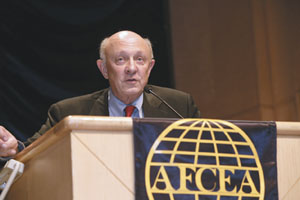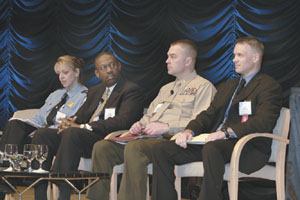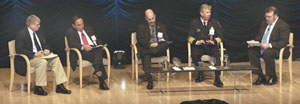Coordination Among Groups Key to Protecting Capital Region
 |
| R. James Woolsey, vice president, Booz Allen Hamilton, moderates the day’s first disaster scenario phase, or Move, on awareness and prevention at AFCEA’s Homeland Security conference. |
The
The event opened with a brief overview of the national capital region (NCR) by Thomas Lockwood, director of the U.S. Department of Homeland Security’s (DHS’) Office of National Capital Region Coordination. He explained that the conference scenario was a different approach that would spark an open conversation between the speakers and the audience about operational expectations, security roles and responses. “Homeland security is a business that everyone participates in,” he said.
Lockwood began by describing the unique characteristics of the NCR. It covers roughly 6,000 square miles and encompasses three jurisdictions: the
The scenario panels, or Moves, set the tone for the event. Each Move focused on one part of a 10-day period leading up to a simulated terrorist attack and its aftermath in the NCR. Members from the organizations that would be involved in responding to each part of the scenario served as panelists.
Move 1 moderator R. James Woolsey, vice president, Booz Allen Hamilton, outlined the situation: A security guard in the
The initial response to the situation would be from local law enforcement organizations, explained Cmdr. Cathy Lanier, head of the
Once enough data is in place to bring in federal law enforcement, the FBI would become the lead agency in an investigation, said Special Agent Grant Rogers, a member of the FBI’s
As the situation evolves, local jurisdictions would be notified with daily briefings. The information gathered from the meetings would be provided not only to law enforcement organizations but also to health care and emergency response groups, shared Calvin Smith, director of the Department of Human Services, Planning and Public Safety for
 |
| Panel members (l-r) Cmdr. Cathy Lanier, commander, Special Operations Division, Washington, D.C., Metropolitan Police Department; Calvin Smith, director, Department of Human Services, Planning and Public Safety, Metropolitan Council of Governments; Lt. Col. Michael Belding, USMC, chief, Plans Division, Joint Force Headquarters–National Capital Region; and Special Agent Grant Rogers, Washington, D.C., field office, Federal Bureau of Investigation; explain how agencies would interact and communicate during a terrorist attack. |
Move 2 focused on integrated emergency management and communications and how government and commercial groups would respond during the incident. It is critically important that telecommunications providers have a preparedness plan, said Dr. Susan R. Bailey, AT&T’s vice president of global network operations. Noting that other events such as fires, floods and hurricanes can affect the national infrastructure, she explained that managers must identify critical assets and have backup services ready. For example, AT&T maintains a fleet of several hundred trailers that can be used to restore service in afflicted areas. Situational awareness also is necessary, she said. Network operators must be aware of irregularities and service spikes, which can be the first indicators of an event.
Preparedness also is vital at the state level, explained John Droneburg III, director of
The panelists concluded that response personnel must be familiar with the equipment they are using to restore communications. Organizations also must take full responsibility for lessons learned from an event, and critical infrastructure providers need to ensure that local operational personnel know whom they must work with in federal and local government agencies.
The second day of the conference began with a keynote address by Maj. Gen. Guy C. Swan III,
Move 3 focused on the response effort and was moderated by Peter LaPorte, senior vice president, Community Research Associates, and former director,
 |
| Move 3 of the disaster scenario discussed how federal, state and local organizations would respond to a terrorist attack. Panel members are (l-r) Bob Marbourg, traffic reporter, WTOP Radio; Brig. Gen. Frank Cardile, USAF (Ret.), vice president, professional services, Lockheed Martin Information Technology; John Contestabile, director, Office of Engineering, Procurement and Emergency Services, Maryland Department of Transportation; James Schwartz, fire chief, Arlington County Virginia Fire Department; and moderator Lacy E. Suiter, emergency management and homeland security consultant, and former associate director, response and recovery, Federal Emergency Management Agency. |
Brig. Gen. Frank Cardile, USAF (Ret.), vice president, professional services, Lockheed Martin Information Technology, said that the private sector would not be in charge of handling the response but would be engaged immediately. It would have to account for people, find a way to keep staff safe and continue to conduct business, especially because many businesses have personnel who support the government and keep command centers running.
The panel discussed at length the importance of a flow of accurate information to the public to keep residents aware and alert to prevent more injuries and confusion. In addition, James Schwartz, fire chief, Arlington County Virginia Fire Department, noted that elected officials need to be prepared to address and reassure the public, since the public chose them to lead. The panelists also considered how they could control the spread of the chemical effects and promote communication between agencies, especially if equipment was damaged in the explosions. The panel explained that authorities would have to decide which facilities to close—for example, the airports—and how many resources to dedicate to disaster relief.
The panel outlined the command, control and communications procedures that would need to be in effect to allow the various responders and the public to work together. By the end of Move 3, the major issue identified was finding a way to have everyone communicating and working together effectively to keep the damage and injury to a minimum. The panel cited failures in response to hurricanes Rita and Katrina as examples of what responders in the NCR have to be prepared for and that need to be improved.
The next segment of the day was the final phase in the attack scenario: recovery. Moderating was Barry West, chief information officer, and director of the Information Technology division, Federal Emergency Management Agency (FEMA). David F. Snyder, assistant general counsel, American Insurance Association, explained that insurers need to reach the people affected by a disaster to help facilitate the recovery process. He advocated a system where the insurance community and the government could work together to provide insurance adjusters access to the area.
Berl D. Jones Jr., acting chief, individual assistance branch, Recovery division, FEMA, told the audience how the agency would assist people with needs such as counseling, unemployment and legal services. He also explained the various programs available to victims of a disaster and how the government sorted out which programs applied to which cases through an application process.




Comments